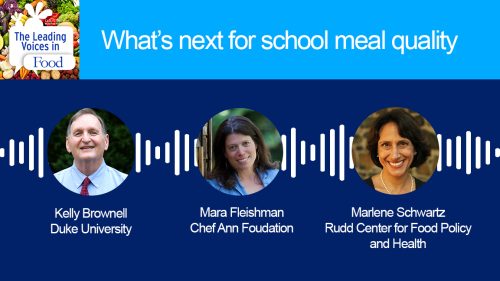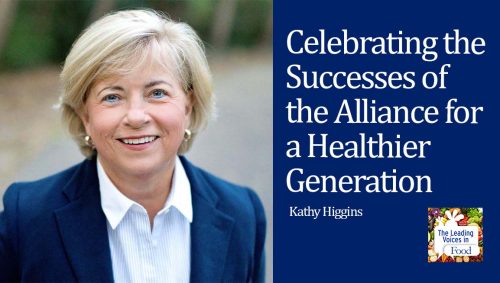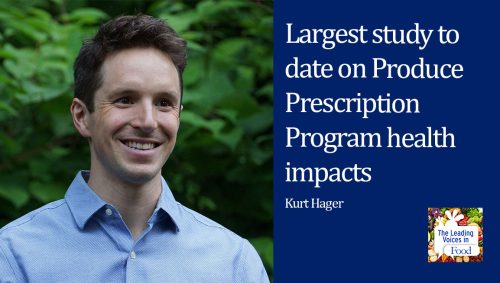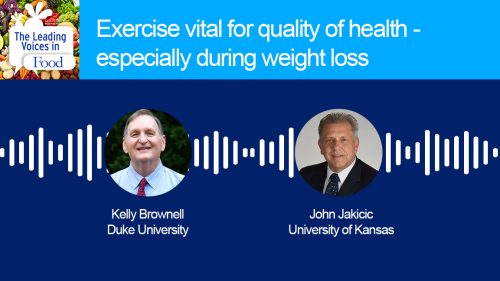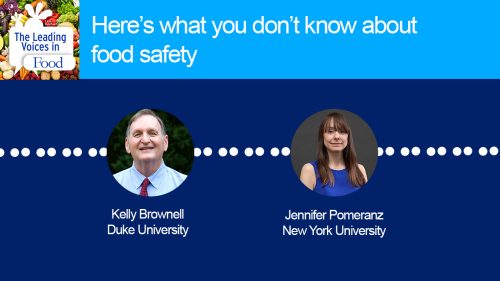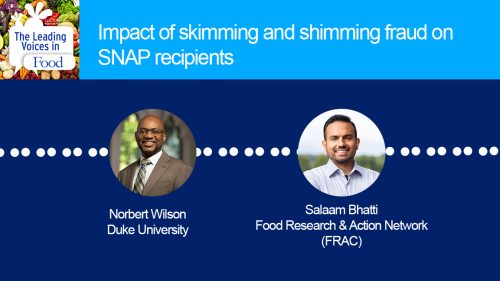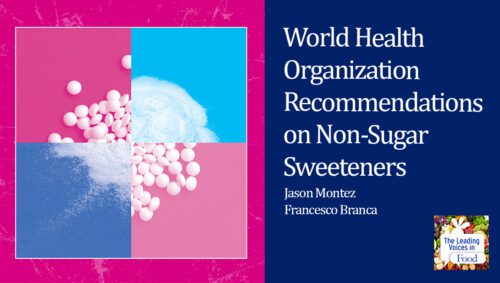The Leading Voices in Food
E144: New York’s Successful Model for Reducing Sugar and Salt
How much sugar and salt do you and others eat each day? What are reasonable and healthy amounts? And when does it become too much? It’s a serious question, given that diet is a key driver for health conditions, such as diabetes and heart disease. The National Salt and Sugar Reduction Initiative, the NSSRI, is working to make it easier for people to make healthy choices. Today’s guest is Andrea Sharkey, a project manager in the Bureau of Chronic Disease Prevention at the New York City Department of Health and Mental Hygiene, an agency long known for its innovation in this area. Andrea coordinates the National Salt and Sugar Reduction Initiative and is going to explain why education, consumer behavior changes, and policies can help our community stay healthy.
Subscribe: Apple Podcasts | TuneIN | YouTube Music | SoundCloud | PocketCasts | Radio Public
Tags: Addiction & Food | Childhood Obesity | Diet & Nutrition | Food Industry Behavior & Marketing | Food Policy | Obesity | Ultra-processed Food & Additives |

Andrea Sharkey is a Project Manager in the Bureau of Chronic Disease Prevention at the New York City Department of Health & Mental Hygiene. Andrea coordinates the National Salt and Sugar Reduction Initiative (NSSRI), an initiative that promotes voluntary and gradual reductions in sugar content in packaged foods and beverages. Additional responsibilities in this role include building nutrition databases for sodium and sugar content analyses, convening the NSSRI partnership, overseeing the development and maintenance of MenuStat (a free online database of restaurant nutrition), and supporting various programs and policies aimed at reducing the burden of diet-related chronic disease. Andrea has an MPH from New York University and a BA from the University of Pennsylvania.
Interview Summary
So this is a highly innovative program, and I remember hearing about it thinking, oh, that’s really cool that someone’s taken the lead on this and has done so in a way that not only applies to their local area, in your case a massive one in New York, but has much broader implications. So let’s talk first about what is the National Salt Sugar Reduction Initiative?
So the NSSRI is a partnership of organizations and health authorities from across the country that we here at the New York City Health Department convene. The initiative was first launched in 2009, and at that time we had set targets to encourage companies to voluntarily reduce sodium in their packaged and processed foods. Targets were set for 2012 and 2014, and during that time we observed about a 7% reduction in sodium content for the categories of packaged foods, in which we set targets. And then in 2018, we turned our attention to reducing sugar in the food supply, using a similar target-based framework and taking advantage of the partnership that we had already created. So this unique approach really encourages companies to voluntarily make gradual and achievable reductions in the amount of sugar in their products.
This is really important because we know that sugar intake is too high and that it’s bad for our health. For example, average consumption of added sugar for every group of Americans is above the recommended limit. And sugar has just become so widespread in the national food supply over time. Research shows us that currently 68% of our packaged foods and beverages that are purchased in the U.S. contain some kind of caloric sweetener. And this makes it really difficult for individuals to reduce their sugar consumption. And we know that this high intake of added sugars is associated with an increased risk of a variety of chronic diseases.
So the intent of these targets is for the food and beverage industry to use them to work toward reducing sugar across specific categories of products. But we also think that there’s a lot of value in these targets for the public health community more broadly. I think they can be useful to advocates and academics to measure progress, and we hope that they can just become an important part of the conversation around reducing the amount of sugar in our food supply, and also make it easier for those consumers that do want to consume less sugar to be able to more easily do so when they’re shopping at the grocery store.
Very ambitious to be doing this. So if you would ask people in general, what should be done if people are consuming too much sugar and too much salt? They’d probably say, well, let’s teach people to eat less of it and put less of it in their food, but you’ve gone about it a different way, trying to work with a company so there’s less than the food supply overall.
So, from a consumer perspective, the intended impact is to work towards a food supply with increased consumer choice so that those wanting to consume less sugar can do so more easily. In an ideal world, we would all eat diets that consist primarily of minimally processed or whole foods. We would all have the time to be able to check all of our nutrition labels and make sure that we’re consuming products that are the healthiest for us, but we know that that’s easier said than done for most Americans for a variety of reasons. Time and cost can be a huge challenge for many, particularly those with lower incomes, and accessibility of affordable, minimally processed foods is just not a reality in many neighborhoods here in New York City and across the country. And we know that this is a result of systematic actions of oppression, things like racism that have historically divested money from communities of color and result in unequal access to healthy foods. So we recognize that education is a part of the process. And we do a lot of work here at the New York City Health Department, and a lot of our partners do as well in terms of educating consumers about their added sugar consumption. But we recognize that the packaged food environment is just a huge barrier. And that’s really what the NSSRI seeks to address. Most people may not realize just how much sugar is in some of the products that they may not even think of as sweet products. So people are often shocked to hear that like a barbecue sauce is as sugar dense as hot fudge. So this just makes it really hard for people to make healthy choices. And so we want to make changes to the food supply so that people have more options when they go to the grocery store and that people who do want to make healthier choices can do so a little bit more easily based on what’s available on the supermarket shelf.
So let’s put some numbers in context. You mentioned that there had been a 7% reduction in the salt, in a number of packaged food products. How important is the 7% reduction?
I think it’s important for a couple of reasons. We know that high levels of sodium consumption is associated with hypertension and cardiovascular disease. So it’s really important to be able to reduce sodium in packaged products gradually over time. I think the sodium reduction targets that we set too, also just brought more attention to the high sodium levels that are in some of the products that are on our supermarket shelves. But what I really like to focus on when I think about the targets and the framework that we laid out is two things, this idea of the food industry being able to be dynamic and innovative in how they reformulate their products. And we saw some pretty significant reductions in sodium in the food supply through a number of companies that committed to meeting those targets. And then the other thing is just the framework more broadly and what our partnership looks like. So just the idea of being able to have a group of over a hundred organizations that I had mentioned earlier, so local health departments, advocacy organizations, professional associations, academic centers, like the World Food Policy Center, all coming together to set one set of sort of shared goals that we can then present uniformly to the food industry is really significant. I think it just goes to show how local jurisdictions can come together to hopefully drive larger national changes in the market.
If I may editorialize for a moment, I think a 7% reduction is a big deal. I mean, first of all, it could be a stepping stone to the larger changes later on, but even in its own right. I think it’s highly meaningful because it’s a lot of products. And so anybody who buys these products is going to be getting less salt, no matter what sort of education or knowledge they have. And then if you add education and knowledge on top of that, you could get sort of a boosted effect. So congratulations for what’s been accomplished. And I’m sure it’s just the beginning of a lot that can go on. Let’s talk about setting targets.
It was a similar process for setting targets for sodium reduction and for sugar reduction. I’ll walk you through the most recent process, which was for the sugar reduction targets. So it was a multi-step iterative process that took us a couple of years and that involved data analysis and collecting feedback from the food and beverage industry. So the first thing we did was we identified the categories of foods and beverages that contributed the most sugar to the U.S. diet and where we ultimately landed was on 15 categories of foods and beverages, which contribute about 60% of sugar to the diet. We have categories like sugary drinks, frozen desserts, and cookies, which consumers may recognize as being high in sugar. But then as I mentioned earlier, we also have categories that may contain a surprising amount of sugar for consumers. So thinking about things like granola bars, yogurts, and sauces. To set targets for each of these categories, we created a database where we merged nutrition information with sales data. And then for each category, we looked at the average sugar content and the distribution across all products in that category. And we weighted that average by sales so that the products that are purchased and presumably consumed most often would factor more heavily into that mean. The next step using this information was to set preliminary reduction targets based on a goal percent reduction from what we assessed at baseline. And we invited the food and beverage industry to provide feedback on those preliminary categories and targets to help us ensure that they were feasible.
We recognize that the food industry, as the reformulation experts know where the public health experts we’re not the food scientists and the reformulation experts. And we know that they’ve demonstrated an innovative and flexible approach to making the food supply healthier in the past is particularly looking at the reduction of sodium that we saw for some of our categories. And we wanted to make sure that they were involved in that target-setting process. So where we ultimately landed, the final set of targets were released in February 2021, earlier this year. The targets are set based on a 10% reduction in sugar by 2023 and a 20% reduction by 2026. For sugary drinks, we’re actually looking for a 40% reduction by 2026. And then companies have the flexibility for how they want to work towards the targets. They can reformulate, they can discontinue high sugar products, they could introduce new lower sugar products, or they could just use marketing to shift the sales to lower sugar products.
Those are very impressive and ambitious goals. And I’m impressed also by the deliberative and thoughtful process that’s gone on to establish those goals and I can see why you have buy-in for so many groups around the country and industry itself. So I can imagine what went into that, how much effort was expended, but congratulations for pulling it off. So let’s talk about the intended impact. So what do you hope will happen with the program?
The idea is to reduce the sugar density of popular processed foods and beverages in an effort to decrease sugar intake of the population overall. Because sugar consumption is coming from so many different categories of foods, the idea here, too, is that if we can reduce the sugar content of each of those categories by a little bit, when you look at some of these diets holistically, that’ll sort of add up to a larger decrease or a larger impact. We want to be able to reduce the amount of sugar in the packaged food supply since we know that the packaged food environment is a huge barrier and be able to provide people with more options. And we’re hoping too, that this will have the biggest impact for consumers who are more reliant on packaged foods or have limited access to whole foods for some of the challenges that I had named previously. Ultimately, we hope that the initiative can reduce inequities in health outcomes by making it easier to consume less sugar, and then have the biggest impact for those consumers who rely most heavily on those packaged foods. I think it’s also worth mentioning too, we recently worked on a paper, which was just published a few weeks ago with researchers from Massachusetts General Hospital and the Tufts Friedman School, which modeled the ideal scenario for the NSSRI. So it was a cost-effective analysis and basically looked at what could happen if all the targets were met by the food and beverage industry, now how much money could this initiative save? And they found that there’d be a cost savings of over $160 billion, in addition to preventing millions of cardiovascular disease events. So again, this was a modeling study. It kind of looks at best case scenario, but in terms of how we’ll assess real-world progress, that database that I described earlier will update over time and rebuild to be able to monitor nutrient and ingredient contents in 2023 and 2026. And we’ll be able to assess progress towards the targets, both overall and at specific category level.
Okay, so you have ambitious goals, you have a lot of buy-in and potentially the sugar and salt can be coming down. So one of the wild card issues, and this is what will consumers do with products that actually have less salt and sugar, and one could say, well, wait a minute, people aren’t going to want these foods as much, and they’re going to be eating less, which probably would not be a problem. But if consumers are buying them, then they aren’t going to want to reformulate because then they won’t be selling as much. So your model here though, is to make gradual shifts in salt and sugar. So people may not even notice these shifts as they’re going along and will just become recalibrated to the different levels of salt and sugar in their diet overall. And in these foods specifically, I’m assuming I captured what the intent is, if not tell me, but is there evidence that this can actually happen, that consumers can shift their taste preferences with time.
You definitely captured that correctly. And I think there’s pretty strong evidence that people’s palates adjust over time to decreases in sodium. I think the evidence is not quite as strong for sugar reduction, but what I will say is that we’ve seen an increase over time in consumer preferences more broadly. I think people are more aware of sugar in some of the products that they’re consuming. And, you know, you’re seeing an increase in seltzer sales, for example. So I think there is this kind of shift happening in the food supply generally, and that this aligns with what consumers are looking for, whether or not companies make these stealth changes or announce that they’re committing to these reductions, from our experience with the sodium targets, it depends on the company. For some companies, they may want to make changes and consumers may not notice, and that would be really gradual. For other companies. It depends on who their consumer base is. If it aligns with their marketing strategy or the mission of the organization overall, to come out and publicly make a statement that they’re going to commit to reducing sugar, that might actually be a helpful kind of marketing tool for them. So that’s one of the reasons why we left some flexibility for companies in how they decide to meet the targets because we recognize that everybody’s consumer-based product portfolio is a little bit different. And so I think it’ll really depend based on the product and based on what the companies are manufacturing.
And the context of this question about can people’s palates adjust as a population very often, the one that gets cited is the case of whole milk. And that at one point people drank almost nothing but whole milk. And now whole milk intake is far less common and people are consuming, skim milk, or 1% or 2%, and they’ve just become adjusted. And a lot of those people, when they drink whole milk, it tastes way too fatty to them. So that’s one example of this occurring. I’d be optimistic that this could occur and you’ve raised one really interesting issue in addition to that, which is how the companies will choose to market these products and whether they’ll gradually reduce sugar and salt and do it in sort of a stealth way, I mean, not hiding anything from consumers, but not boasting about it, if you will. And others might want to use that as a marketing tactic. So it’ll be interesting to see how that goes. So let me ask you a question about how this policy might fit with other policies intended to reduce things and so let’s talk about sugar consumption in particular. So for example, is this an alternative to policies that have been made around sugary drinks?
It’s a good question. So, no, we don’t view the NSSRI as an alternative to other policies. You know, setting voluntary sugar reduction targets really compliments other local and national efforts. So there are existing policies, programs, and educational campaigns that are taking place across the country led by many of our NSSRI partners to help Americans reduce their added sugar consumption. And the way we think about it is because diet-related disease is such a complex and multifaceted issue that really affects every city and state in the nation. We need innovative and complimentary approaches to address this. So we recognize that a number of potential strategies can be taken to reduce the intake of added sugar. And while strategies like education and regulatory approaches have been implemented across the country, the NSSRI is unique because as I had mentioned, it aims to work with the food industry. So it’s really more of an upstream approach that has the potential to reach all consumers, but may have the largest impact on those consumers that are eating the largest amounts of packaged foods. And if companies work toward these targets, the changes will be made to the products before they even arrive on the supermarket shelves. I think one of the other things that’s really different about this initiative too, is the partnership, which is really unique and just the coming together of health departments, advocacy organizations, professional associations, the model has just demonstrated that this collective action by smaller groups can influence policy nationwide.
For one final question, what’s been the impact of COVID-19 on Americans eating habits, and should we be concerned about this?
So the COVID-19 pandemic has certainly exacerbated food insecurity. Speaking specifically for New York City, we experienced historically high unemployment rates, which created a lot of financial instability. And we also saw the closure of institutions like senior centers and public schools where a lot of New Yorkers, reliably accessed meals prior to the pandemic. I think it’s going to be interesting to learn more about other shifts in eating patterns as more data becomes available. I’ve seen some anecdotal evidence that suggests an increase in reliance on packaged food, more people shifting to online grocery shopping, if that’s an option available to them. And for a time, I think it’s also possible that folks ate out at restaurants less often, just because so many places were shut down. But at this point it’s still pretty unclear whether any changes in eating patterns that we saw over the past year and a half will remain as COVID becomes less of a public health emergency. But for us, this really emphasizes why it’s important to make the packaged food supply less unhealthy. I think that we saw, and we’re still seeing that the current public health landscape demonstrates that diet really remains critical because we have this public health emergency like COVID-19, but we’re seeing that diet-related health conditions such as diabetes and heart disease can increase the risk of severe illness from COVID-19. And so this makes us feel like this initiative and all of the work on chronic disease prevention that we’re doing is especially important to address right now. And perhaps now more than ever.




